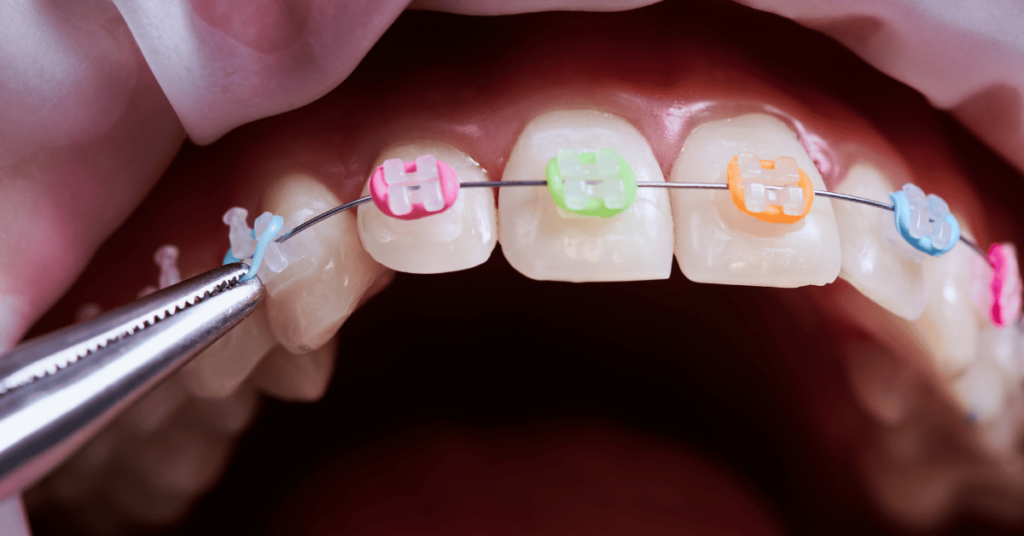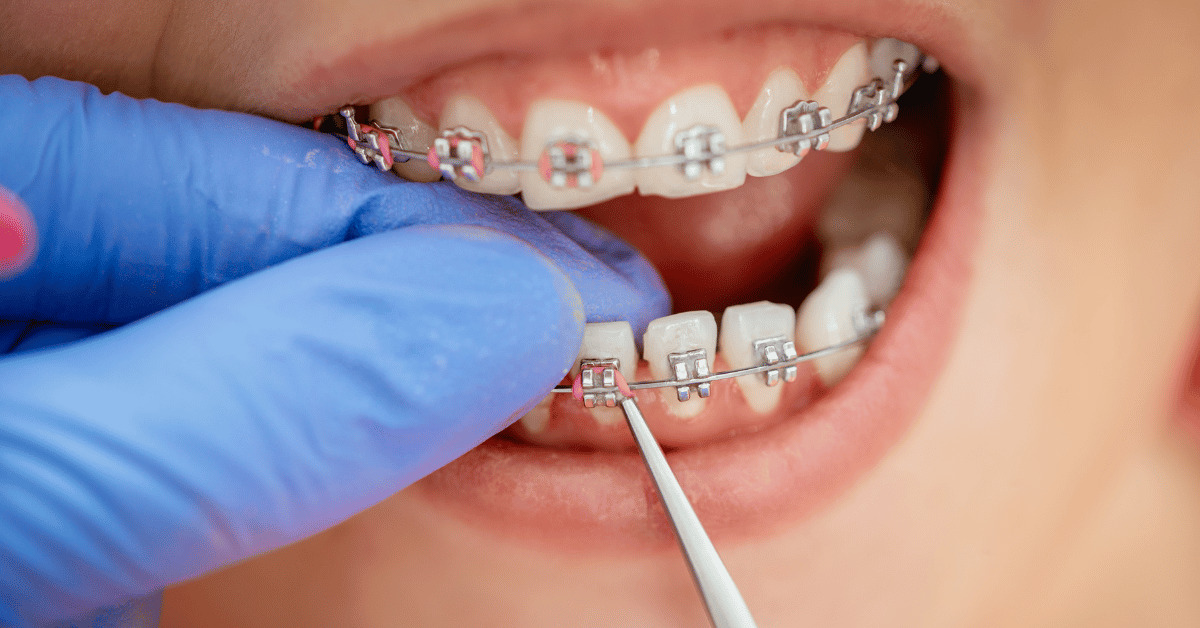Many people wonder “What do rubber bands do on braces?” The simple answer is, they bind teeth closer together, in the same way that rubber bands bring anything closer together. When you or your child needs braces, you may hear of the need for Orthodontic Elastic Bands that will serve as rubber bands for braces. These bands help even out the teeth and align the bite in the mouth.
When an orthodontist prescribes braces rubber band treatment, it is to treat bite alignment, and to correct issues such as an overbite or underbite. Rubber bands do move the jaw and teeth, and that is the point of them. They are used to pull the teeth together and to help the braces do their job. If you don’t wear your orthodontic rubber bands, you may find that you are wearing braces for a longer period than necessary.
Purpose of Rubber Bands in Braces
The primary purpose of rubber bands for braces is to help with teeth alignment. Orthodontic Elastic Bands are used to provide a force on the teeth that works with the brace brackets that have been attached to the tooth’s surface. That force from the rubber bands helps to align your mouth and your jawline. You may need to wear rubber bands for braces on each of your teeth, or on a specific section of your mouth that needs some additional assistance when it comes to correcting an underbite or an overbite.
A rubber band is placed on the brace with the assistance of a metal hook. Those hooks are small and connected to the bracket of the brace, and are for rubber bands if they are necessary. The rubber band can be extremely effective in aligning a jaw or correcting an overbite or underbite, or other common teeth alignment issues. The most common reasons to get braces at all are overbites, underbites, open bites, and crossbites. Each of these different kinds of alignment problems with the jaw may require rubber bands with braces. Braces rubber band treatment is very effective in shortening the amount of time it takes to treat a jaw alignment problem. Like the brackets on your teeth, the rubber bands will move your teeth and jawline.
An overbite is a condition that is also known as buck teeth. This occurs when the upper row of teeth protrudes over the bottom row of teeth. This is a problem and misalignment of the jaw that can be very severe. Some people may choose to live with this without getting braces, for cost factors, or just because they don’t mind the alignment problem. At the same time, you may find that damage to the gums can be caused as a result of this alignment issue. Braces and rubber bands with braces can be very effective in treating this issue.
An underbite is the opposite, where it is the bottom row of teeth that protrudes past the top row of teeth. To some, this is much like a bulldog where the mouth almost appears to jut out on occasion. This issue can be a bigger problem health-wise than an overbite, as an underbite can make it very difficult to chew food and speak in some cases. You might even experience pain in the mouth or face if the jaw is not aligned properly.
The condition known as an open bite is another mouth condition that can effectively be treated with braces and rubber bands for braces. In this condition, there is a small space between the upper set of teeth and the bottom set of teeth. In this case, it looks like the back teeth will meet when the mouth is closed but there is a space between the top and bottom teeth. This is why it is called an open bite. This kind of tooth issue can make it difficult to make certain sounds or pronounce things a certain way. It can also prevent someone from chewing food properly or effectively.
A crossbite is another condition that can effectively be treated with braces and rubber bands for braces. In this condition, the bottom teeth are slanted inwards, and the upper set of teeth fit almost inside the bottom teeth. Braces are used to correct the spaces and the slants and to position the teeth in a much more effective way. This is referred to as an anterior crossbite. The situation can be reversed here, where the bottom teeth fit inside slanted upper teeth in what is called a posterior crossbite.
The primary purpose of braces and rubber bands that are used with them is to correct any one of these types of jaw misalignment. There are different types of elastics used, and they each have their own function. They are called Class I, Class II, and Class III elastics. Case I elastics will close gaps between the teeth and run over the molars. Class II elastics will reduce overbites by bringing upper teeth backward and lower teeth towards the front. Class III elastics resolve underbites by bringing the lower teeth backward and moving forward the upper teeth.
Other types of bands for braces include vertical and cross. The vertical type will link your teeth on the upper jaw with braces below in order to correct open bites. A crossbite issue will be corrected with rubber bands that connect both jaws to correct the crossbite.
Each of these types of rubber band has a different kind of force related to it. There are light, medium, and heavy forces with these elastic bands that help to accomplish the purpose of aligning the jaw properly. There are latex rubber bands for braces and synthetic brands, but the latex brands will often have stronger stability to them.

What to Expect When Wearing Rubber Bands for Braces
It can be tempting to remove the elastic bands when you have braces, but you will just need to remember the answers to the main question, what do rubber bands do for braces? There are different needs for rubber bands for braces, and each kind of jaw misalignment will use rubber bands for braces in a different way. Not every person that needs braces will need rubber bands, but if you do need them, you want to know what to expect when you get them. Most orthodontists will tell you that you need to wear them at all times in order to achieve the best results. Like wearing the braces themselves, you may experience some pain and discomfort during some of the time that you are wearing them, but they will shorten the amount of time you have to wear braces.
You will find that you may need to change the elastic bands frequently, as they will lose their elasticity or you may even lose them on occasion. If the rubber bands lose their elasticity, they also lose their primary purpose. They will need to be changed frequently, and it is always a good idea to carry extra with you. If you aren’t sure how often you should change the rubber bands, talk to your orthodontist about elastic bands for braces and what the preferred routine is for changing them.
You also need to find out how much you can eat with the rubber bands, and you may even need to remove them to eat. It may sound complicated, but you will get used to wearing rubber bands with braces in time, and learn how to change them frequently.
You may find that there is a little bit of discomfort with wearing rubber bands. Rubber bands will add pressure above and beyond the pressure that braces put on your teeth, and it could cause some pain. You also want to be sure you have the right kind of rubber bands, particularly if you have a latex allergy. Overall, it will just take some practice to get used to your Orthodontic Elastic Bands, but you will find it becomes routine soon enough.
Follow Orthodontist Instructions for Optimal Treatment Results
The main purpose of wearing Orthodontic Elastic Bands is to speed up the timeline of how long you need braces. You can wear them for a significantly shorter amount of time when you use rubber bands for braces. Although every situation will be different, you can shorten your braces time by as much as eight months when you use rubber bands. When you are getting braces, following your orthodontist’s treatment plan to the letter is the best way to maximize your experience with braces, and shorten the time you have to wear them.
It is best to wear elastic for 24 hours daily unless your doctor tells you otherwise. You can remove them to eat and brush your teeth in most cases, and this will help you to learn the routine of wearing the rubber bands. Change your elastic bands frequently, because it is their elasticity that is helping your braces do their job. It is always a good idea to carry a package of elastics with you when you leave the house, to ensure that you have extras if you need to eat or brush your teeth when you are out.
You also want to make sure that you don’t double the elastics on your braces, as this will create too much pressure on the braces. This will not shorten the amount of time you wear braces, will cause great discomfort, and damage the treatment plan set forth by your orthodontist. Take very good care of your teeth as your orthodontist recommends, and you will become one with your braces and elastics and get into a set routine quickly.
Treat Your Braces Well
When you need rubber bands for braces, it is to put extra force and pressure on your braces so that they do their job and align your jaws easily and quickly. Orthodontic Elastic Bands work well to shorten the amount of time that you need to wear braces altogether. When you have them, follow the treatment plan scheduled by your orthodontist and you will find that wearing braces becomes easy and routine in no time.
